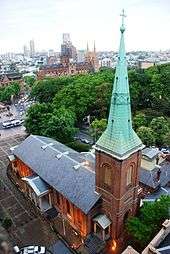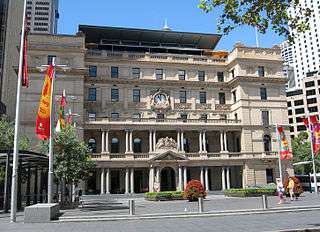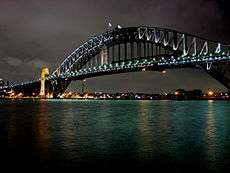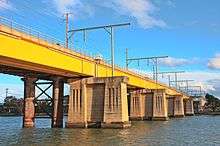Architecture of Sydney

The Architecture of Sydney is not characterised by any one architectural style, but by an extensive juxtaposition of old and new architecture over the city's 200-year history, from its modest beginnings with local materials and lack of international funding to its present-day modernity with an expansive skyline of high rises and skyscrapers.
Under the tenure of early nineteenth-century Governor Lachlan Macquarie, the works of Francis Greenway were the first substantial buildings for the fledgling colony. Later prominent styles were the Victorian buildings of the city centre created out of local Sydney sandstone, and the turn of the century Federation style in the new garden suburbs of the time.
With the lifting of height restrictions in the post-World War II years, much of central Sydney's older stock of architecture was demolished to make way for modernist high rise buildings. Some of the most notable new buildings were designed by the Austrian-Australian architect Harry Seidler, as well as by international architects such as Jørn Utzon, Jean Nouvel, Richard Rogers, Renzo Piano, Norman Foster or Frank O. Gehry.
1788-1820s: The new colony's restrained Georgian style
The British established a colony in Sydney Cove in January 1788 after the First Fleet sailed 9 months from Portsmouth. The early years of the colony suffered from a sense of provisionality and the attitude of the majority of convicts and their guardians that they would return to Britain once they had "done their time." The colony was poorly equipped, had little food supplies, and did not understand the climate or soil. For its first two years it faced starvation. In 1790, Governor Phillip began the process of freeing convicts and granting them land, such as that at Rose Hill 20 km inland which provided a stable food supply to the colony.[1]
The British Government did not provide architects, builders to the new colony, or useful tools. Request for building tools were responded to tardily with more inappropriate tools, which was seen as a sign that the British Government was reluctant to invest money in a penal colony, even though the number of free settlers was increasing. Amateur builders took time to work out what local materials were suitable.

Those significant buildings that were built were of such poor workmanship and materials that they needed constant maintenance. Lieutenant William Dawes produced a town plan for Sydney in 1790 but it was ignored in the under-resourced and often lawless society, and Sydney's layout still shows this lack of planning.[1] The earliest significant buildings in Sydney were simple restrained Georgian buildings that were suited to the climate (often by virtue of deep verandahs), available materials and craftsmanship, and were based in a spirit of making do and improvisation.[1]
Governor Macquarie's tenure began in 1810 and he promoted the idea of Sydney as a successful society of free citizens. He commissioned a survey of all aspects of the colony including its buildings which he found to be in a "most ruinous state of decay". He implemented a basic building code with certain minimum standards for new buildings and a requirement a plan be submitted for new buildings. He saw his role as one of nation-building with a responsibility to provide facilities that were functional and provided a sense of community pride. By the end of his tenure, Macquarie had overseen the construction of 92 brick buildings, 22 stone buildings, 52 weatherboard houses, four bridges, seven quays and moles, and over 200 miles of road. In 1814, Francis Greenway, a convict serving a fourteen-year sentence for forgery, arrived in Sydney.
Over a short period of time, a partnership between him and Macquarie saw the construction of fine public buildings that were classically inspired, restrained decoratively and well-portioned and included Hyde Park Barracks, St James Church and St Matthews at Windsor. An 1819 commission of inquiry into the colony accused Macquarie of extravagance particularly in regard to construction and he was recalled to England. This effectively ended Greenway's career and little public construction was carried out until the late 1830s.[1]
1830s to 1850s: eclectic neo-Gothic
Population growth, the granting of perpetual leases on town properties, the encouragement of free trade and exports underpinned a booming economy. Since the beginning of the colony, officers and administrators were housed on the eastern side of the Tank Stream, while lower ranks and commerce was consigned to the western side. By the 1830s this had become entrenched with fine homes on the Potts Point ridge. The derivative neo-Classical Georgian style was being replaced with the more ornate and eclectic Gothic Revival. John Verge was the most renowned architect in the 1830s and his buildings included Tusculum in Potts Point, Elizabeth Bay House, and Camden Park.[1]
The 1840s saw an increasingly buoyant economy and confident society pushed along by the end of convict transportation and the commencement of an independent legislature. A building boom embraced the neo-Gothic style whereby the colony's strong need to identify with the home country was manifest.[1] Public, commercial and domestic architecture overlooked the local climate in favour of styles transported from Britain, and projects with substantial budgets often produced an indiscriminate eclecticism. Conversely, projects with limited budgets that precluded ostentatious and derivative design often resulted a kind of vernacular style that responded to local conditions. Rather than a connecting device between rooms, the verandah became a sun-shading device, and solid sandstone walls and cross-ventilation stabilised both cold and hot temperature extremes.[1]
1850s - Victorian architecture

Victorian aspirations for respectability, formality, and materialism were compounded in Sydney by colonial yearning for respect, which in architecture resulted in the copying of imported styles, mostly from Great Britain. New wealth and rapid increase in population came with the 1850s gold rush. A new middle class emerged who wanted homes, cities and public buildings that matched their new wealth and social status and construction of high quality buildings such as churches, commercial and public buildings, and ostentatious houses of the wealthy boomed. On the other hand, housing for the working and lower middle class remained substandard and the prevalence of unhygienic and slum conditions grew.
In the 1860s, architecture in Sydney focussed more on style than consideration of the building's function in relation to its setting and climate. An increase in Italian immigrants influenced residential construction which manifest itself in a growing popularity of surface ornamentation, plasterwork, squared massing, arcades and loggias, and square towers. The simplicity of early colonial architecture was replaced by decorative facades using ornate cast iron with higher ceilings featuring elaborate mouldings.
Major new civic buildings included Edmund Blacket's Main Quadrangle Building at the University of Sydney completed in 1859. James Barnet was Colonial Architect from 1862 and was Sydney's most prolific Victorian architect.[2] His buildings included The Australian Museum (1864), Customs House (1884), the General Post Office (1890), the Lands Department Building (1881 & 1893) and the Chief Secretary’s Building (1878). He also was responsible for many suburban post offices, court houses and other civic buildings. Most of Sydney's public buildings from this time, including Barnet's, were built from local stone and were a variety of styles including Italianate, Gothic, and neo-Classical with heavily worked façades. The early 1860s saw a renewed interest in the use of brick. Mass production of bricks commenced in the 1870s, although hand production continued until the end of the 19th century.
By 1880, two thirds of the population had been born in Australia and a growing nationalism viewed the country as paradise compared to the Old World. With a booming economy, Australians sought to prove they could compete with the Old World.
Post World War II

The Great Depression and World War II created a severe housing shortage for Australia in the late 1940s. A shortage of materials and skilled labour compounded the shortages, as did restrictive bank lending practises whereby it was the norm for borrowers to put up a deposit of 50% of the value of a house. Building plots of around 115 square metres aggravated the problems further. These factors fed a building industry recession and the cost of building home in the decade following the war grew by 600%.[3] In response, young architects who had worked in Europe and returned to Australia brought a simplicity to design and construction and renewed interest in logical structure and free planning. Verandahs and porches were less common on houses, and slightly pitched roofs replaced hipped roofs. Designs no longer featured non-functional ornamentation, ceilings were lower and rooms were expected to be multi-purpose. Vestibules were eliminated, hallways, and separate dining and living rooms were eliminated and the main entry was directly into the living room.[3]

Harry Seidler was instrumental in the introduction of Internationalism to Sydney. He studied under Walter Gropius at Harvard, worked with Marcel Breuer, and had been tutored by Josef Albers at Black Mountain College. The Rose Seidler House, for his parents, was the first of 10 buildings he built in Sydney between 1948 and 1952. The house was a revelation to conservative 1950s Sydney.[4]
In contrast to Seidler's strongly European flavour of Modernism was the softer form practised by the so-called Sydney School of the 1950s and 1960s. This loose collection of architects, comprising, among others, Bill Lucas, Bruce Rickard, Neville Gruzman and Ken Woolley, favoured organic and natural houses, often built on steep slopes and hidden from view in natural bushland. These projects were largely on the city's North Shore, and to a lesser extent in the Eastern Suburbs. Following on from Walter Burley Griffin's work in the Sydney suburb of Castlecrag, this style of Australian architecture was visually sensitive to the environment and, like Griffin, often utilised natural local materials as structural elements.[5]
In the central business district, the lifting of height restrictions heralded the beginning of the city's change into a largely high-rise city.[3]
Opened in 1973, the Sydney Opera House was designed by Danish architect Jørn Utzon.[6] Its construction was partly financed by the Opera House Lottery. Utzon left in acrimonious circumstances before the building was finished; later work was completed by other architects. Located on Bennelong Point on Sydney Harbour, the building is a World Heritage Site.[7] The tallest point in the city is the Sydney Tower built in the late 1970s-early 1980s, when height restrictions were far more lenient. The observation tower provides views of the entire city.
Prominent styles
QVB-9.jpg)


Gothic revival
- Government House, Bennelong Point
- St Philip's Church, Clarence Street
- Bishopscourt, Greenoaks Avenue, Darling Point
- The Abbey, Johnston Street, Annandale
- Gladeswood House, 11 Gladeswood Gardens, Double Bay
- St John's Church, Darlinghurst Road, Darlinghurst
Georgian
- Durham Hall, Albion Street, Surry Hills
- Cleveland House, Bedford Street, Surry Hills
- Waimea, Waimea Avenue, Woollahra
- Judge's House, 531 Kent Street
- Juniper Hall, Oxford Street and Ormond Street, Paddington
Classical
- Customs House, Alfred Street, Circular Quay
- General Post Office, Martin Place
- Lands Department, Bridge Street
- Art Gallery of New South Wales, Domain
- State Library of New South Wales, Macquarie Street
- Australian Museum, College Street
- Darlinghurst Court House, Taylor Square
Romanesque
- Queen Victoria Building, George Street
- Church of St John, Bishopthorpe, St Johns Road, Glebe
- Société Générale House, 348 George Street (originally the Equitable Life Assurance Society of America)
- Burns Philp and Company building, Bridge Street
- St Andrew's Church, 56 Raglan Street, Manly
Italianate
- Central Police Court, Liverpool Street
- Former New South Wales Club, 31 Bligh Street
- Colonial Secretary's building, Bridge Street
- Holyrood (facade), Santa Sabina College, The Boulevarde, Strathfield
- Rockwall, Macleay Street, Potts Point
- Stead House, Leicester Street, Marrickville
Federation/Edwardian
- Pyrmont Fire Station, Gipps Street and Pyrmont Bridge Road, Pyrmont
- YMCA, 325 Pitt Street
- Former ANZ Bank, 52 Oxford Street, Darlinghurst
- Former hotel, 2-4 Riley Street, Woolloomooloo
- Hotel building, 225 George Street
- Commercial Building, 161 Sussex Street
- Post Office, King Street and Erskineville Road, Newtown
- Commercial building, 469 Oxford Street, Paddington
Second Empire
- Sydney Town Hall, George Street
- Downing Centre (former Mark Foy building), Liverpool Street
Queen Anne
- Westmaling, Penshurst Avenue, Penshurst
- Caerleon, Bellevue Hill
- Homes, Appian Way, Burwood
-

Former ANZ Bank building, Oxford Street
-
Burns Philp Building, Bridge Street (1901)
-

Customs House, Circular Quay
-
Queen Victoria Building, George Street
-

Sydney Town Hall, George Street
Skyscrapers

.jpg)
With 146 skyscrapers over 90m, Sydney has the largest skyline in Australia.[8] Height restrictions were lifted in the 1950s and the AMP Building at Circular Quay became Australia's tallest building several years later. The late 1980s and early to mid-1990s saw a skyscraper boom in Sydney, but height restrictions limited future buildings to the height of 235 metres, in part due to the close proximity of Sydney Airport. The largest structure is Centrepoint Tower standing at 309 metres, containing restaurants and observation decks. Although both the MLC Centre and World Tower are higher measured to roof at 228m and 230m respectively, the tallest conventional skyscraper measured to its spire tip is the Citigroup Centre at 243m, completed in 2000.
Tallest Buildings[9]
- Sydney Tower 309m
- Citigroup Centre 243m
- Chifley Tower 241m
- Deutsche Bank Place 240m
- Meriton World Tower 230m
- MLC Centre 228m
- Governor Phillip Tower 227m
- Ernst and Young Tower 222m
- RBS Tower 219m
- ANZ Tower 195m
-
MLC Centre
-

Chifley Tower
Bridges

There are 23 major bridges within Sydney. There are no significant suspension bridges. Instead, there is a mix of more modest girder, truss and cable bridges. The most iconic bridge in the city, the through arch Sydney Harbour Bridge, links the North Shore with the CBD across Port Jackson. The design was influenced by New York City's Hell Gate Bridge. It is the sixth longest spanning-arch bridge in the world and the tallest steel arch bridge, measuring 134 m (440 ft) from top to water level.[12] The Anzac Bridge is an 8-lane cable-stayed bridge spanning Johnstons Bay between Pyrmont and Glebe Island.
-
A full view of Iron Cove Bridge, which crosses the Iron Cove Bay on the Parramatta River.
-
Ryde Bridge from Meadowbank
-

Tom Uglys Bridge, crossing Georges River
-

Anzac Bridge from Rozelle
Residential architecture
Of the sixty-odd styles that developed in Sydney over the years, more than half were used in residential architecture. Prominent residential styles included:
Old Colonial Period
- Georgian
- Regency
- Grecian
Victorian Period
- Free Classical
- Filigree (featuring wrought iron balconies)
- Italianate
- Gothic
- Tudor
Federation Period
- Free Classical
- Filigree (featuring woodwork instead of wrought iron)
- Queen Anne (the dominant residential style between 1890 and 1910)[13]
- Bungalow (featuring prominent verandah)
- Arts and Crafts (including Shingle style)
Inter-War Period
- Georgian Revival
- Free Classical
- Mediterranean
- Spanish Mission
- Gothic
- Old English
- California Bungalow
Post-War Period
- International
- American Colonial
Late Twentieth Century Period
- Organic
- Sydney regional
- Tropical
- Late Modern
- Australian Nostalgic
- Immigrant Nostalgic
Residential architecture
-

Victorian Filigree home, Bondi Road, Bondi
-

The Priory, an Italianate home, Burwood Road, Burwood
-

Merrivale, a home in the Regency style, Pymble
-
Cranbrook_Avenue_house.jpg)
Two-storey Bungalow, Cremorne
-
Caerleon.jpg)
Caerleon, Bellevue Hill, New South Wales, the first Federation Queen Anne home in Australia
-
Pibrac, a home in the Shingle style, Warrawee (designed by John Horbury Hunt)
-
Horbury Terrace apartments in Georgian style, Macquarie Street
-
cottage_Oxford_Street-1.jpg)
Cottage in Arts and Crafts style, Bondi Junction
-
Fernlea_in_Wahroonga.jpg)
Fernlea, a Federation Bungalow, Wahroonga, New South Wales
-

Contemporary home, Mosman
-

The Rose Seidler House in the city's North Shore was the first Modernist/Internationalist style building in Sydney. It is now open to the public as a museum.
-
Old_English_style_house_Killara-1.jpg)
Old English house common within Killara
See also
- List of heritage houses in Sydney
- List of Art Deco buildings in Sydney
- List of tallest buildings in Sydney
- List of tallest buildings in Oceania
- Architecture of Melbourne
- Terraced houses in Australia
References
- 1 2 3 4 5 6 7 McGillick, Paul; Bingham-Hall, Patrick (2005). Sydney Architecture. Singapore: Tuttle Publishing. pp. 14–15. ISBN 0-7946-0334-3.
- ↑ Barnet, James (29 July 1899). "Architectural Work in Sydney New South Wales 1788-1899" (PDF). Journal R.I.B.A. VI (17): 503–518. Retrieved 13 July 2015.
- 1 2 3 McGillick, Paul; Bingham-Hall, Patrick (2005). Sydney Architecture. Singapore: Tuttle Publishing. p. 106. ISBN 0-7946-0334-3.
- ↑ McGillick, Paul; Bingham-Hall, Patrick (2005). Sydney Architecture. Singapore: Tuttle Publishing. p. 108. ISBN 0-7946-0334-3.
- ↑ "So last century". The Sydney Morning Herald. 2006-04-13.
- ↑ House History Archived 16 July 2006 at the Wayback Machine.; Sydney Opera House website (accessed 2006-07-24)
- ↑ Entry for Sydney Opera House; UNESCO World Heritage Centre (accessed 2006-07-24)
- ↑ The World's Best Skylines
- ↑ Daily Telegraph June 11, 2014, p.6
- ↑ "Widest Bridge". Guinness World Records. Retrieved 15 September 2012.
- ↑ "Port Mann Bridge". TRANSPORTATION INVESTMENT CORPORATION. British Columbia: Province of British Columbia. 2007. Retrieved 15 September 2012.
Once complete, the new 10-lane Port Mann Bridge will the second largest and longest cable-supported bridge in North America, and at 65 metres wide it will be the widest bridge in the world.
- ↑ "Sydney Harbour Bridge". culture.gov.au. Australian Government. Retrieved 1 October 2010.
- ↑ A Pictorial Guide to Identifying Australian Architecture, Apperley (Angus and Robertson) 1994, p.132
External links
- Sydney Architecture Walks, architect-led tours of Sydney
- Archiseek.com: Sydney
- The City, Sydney walking tour by Sydney Architecture Walks
- Five Suburb Sydney Dérive - architectural bike tour by Sydney Architecture Walks
- Sydney City Architecture Walk by Australian Architecture Association
- Walk Through Time in Sydney City by Australian Architecture Association*A mapping of historic buildings in the inner city
- Gallery of Buildings in Sydney
- Gallery of Sydney Architecture
- Australian Architectural Styles
- The Skyscrapers of Sydney - A video guide to the Sydney skyline
- Dictionary of Sydney - Buildings
| Wikimedia Commons has media related to Federation Architecture of Australia. |
| Wikimedia Commons has media related to Houses in Sydney. |
| Wikimedia Commons has media related to California Bungalow architecture in Australia. |

.jpg)


